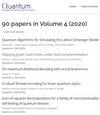量子理论中的强子散射波包:量子计算机上的准备工作
IF 5.1
2区 物理与天体物理
Q1 PHYSICS, MULTIDISCIPLINARY
引用次数: 0
摘要
量子模拟有望完整描述标准模型规理论中的高能散射过程。这种模拟的第一步是准备相互作用的强子波包。为了创建波包,人们通常采用绝热演化来连接自由理论中的波包和相互作用理论中的波包,这使得模拟需要大量资源。在这项工作中,我们直接在相互作用理论中构建了一个波包创建算子,以规避绝热演化,同时利用了资源节约型的基态准备方案,如变分量子优解器。通过对约束规规理论中的约束介子激元进行反演,并随后使用经典或量子方法对其进行优化,我们表明,使用我们开发的数字量子算法,可以高效、准确地创建相互作用介子波包。具体来说,我们在 1+1 维与费米子物质耦合的 $Z_2$ 和 $U(1)$ 格规理论中获得了高保真介子波包。我们的方法适用于耦合的微扰和非微扰状态。我们在Quantinuum $texttt{H1-1}$困离子量子计算机上建立并实现了Z_2$格规理论情况下的波包创建电路,使用了13个量子比特和多达308个纠缠门。在采用了一种简单的基于对称性的降噪技术后,其保真度与经典基准计算结果吻合得很好。这项工作为量子色动力学中的散射过程的量子计算迈出了一步。本文章由计算机程序翻译,如有差异,请以英文原文为准。
Scattering wave packets of hadrons in gauge theories: Preparation on a quantum computer
Quantum simulation holds promise of enabling a complete description of high-energy scattering processes rooted in gauge theories of the Standard Model. A first step in such simulations is preparation of interacting hadronic wave packets. To create the wave packets, one typically resorts to adiabatic evolution to bridge between wave packets in the free theory and those in the interacting theory, rendering the simulation resource intensive. In this work, we construct a wave-packet creation operator directly in the interacting theory to circumvent adiabatic evolution, taking advantage of resource-efficient schemes for ground-state preparation, such as variational quantum eigensolvers. By means of an ansatz for bound mesonic excitations in confining gauge theories, which is subsequently optimized using classical or quantum methods, we show that interacting mesonic wave packets can be created efficiently and accurately using digital quantum algorithms that we develop. Specifically, we obtain high-fidelity mesonic wave packets in the $Z_2$ and $U(1)$ lattice gauge theories coupled to fermionic matter in 1+1 dimensions. Our method is applicable to both perturbative and non-perturbative regimes of couplings. The wave-packet creation circuit for the case of the $Z_2$ lattice gauge theory is built and implemented on the Quantinuum $\texttt{H1-1}$ trapped-ion quantum computer using 13 qubits and up to 308 entangling gates. The fidelities agree well with classical benchmark calculations after employing a simple symmetry-based noise-mitigation technique. This work serves as a step toward quantum computing scattering processes in quantum chromodynamics.
求助全文
通过发布文献求助,成功后即可免费获取论文全文。
去求助
来源期刊

Quantum
Physics and Astronomy-Physics and Astronomy (miscellaneous)
CiteScore
9.20
自引率
10.90%
发文量
241
审稿时长
16 weeks
期刊介绍:
Quantum is an open-access peer-reviewed journal for quantum science and related fields. Quantum is non-profit and community-run: an effort by researchers and for researchers to make science more open and publishing more transparent and efficient.
 求助内容:
求助内容: 应助结果提醒方式:
应助结果提醒方式:


